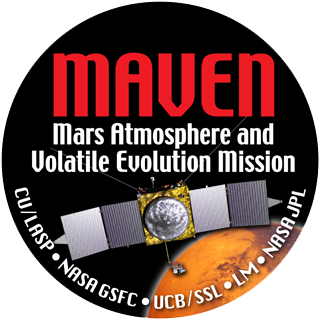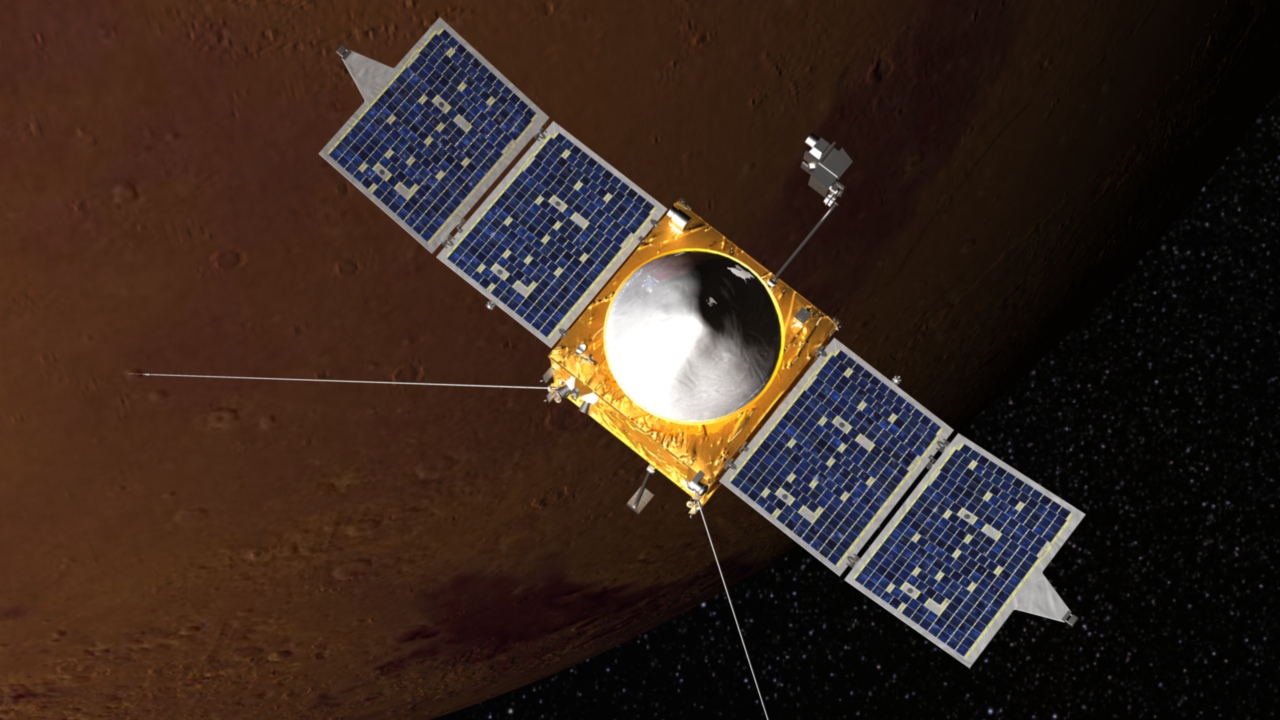- A mass spectrometer to determine global characteristics of the upper atmosphere and ionosphere,
- An ultraviolet spectrometer to characterize the upper atmosphere and ionosphere,
- A solar EUV irradiance monitor and
- A fields and particles integrated package for in situ measurements. Included in the package are: LPW, SWEA and SEP to measure electrons and SWIA and STATIC to detect ions, while magnetic fields and electric fields are recorded by MAG and LPW respectively.
- In addition, accelerometer data is acquired in the 5 "deep-dip" campaigns to sample the lower atmosphere

Mars Atmosphere & Volatile Evolution Mission (MAVEN)
PDS4 Primer:
Instrumentation and Access to Data:
The instrument complement consists of:
Archive Bundles
The Mars Atmosphere and Volatile Evolution Mission (MAVEN) was launched Nov XX, 2013, to explore the planet's upper atmosphere, ionosphere and interactions with the sun and solar wind. After a 10 month ballistic cruise the craft went into orbit XX Sept 2014. The primary mission was planned to last for one earth year. To obtain coverage of near Mars space the mission was designed with an elliptical orbit that precessed in latitude and local solar time. The mission plan included nominal orbits that have periapsis near 150 km, with 5 "deep dip" campaigns with periapsis near 125 km.
Basic Mission Goals
Determine the role that loss of volatiles from the Mars atmosphere to space has played through time
Determine the current state of the upper atmosphere, ionosphere, and interactions with the solar wind
Determine the current rates of escape of neutral gases and ions to space and the processes controlling them
Determine the ratios of stable isotopes that will tell Mars' history of loss through time
For more information on the MAVEN mission see the following links:
Basic Mission Goals
Determine the role that loss of volatiles from the Mars atmosphere to space has played through time
Determine the current state of the upper atmosphere, ionosphere, and interactions with the solar wind
Determine the current rates of escape of neutral gases and ions to space and the processes controlling them
Determine the ratios of stable isotopes that will tell Mars' history of loss through time
For more information on the MAVEN mission see the following links:
PDS4 Primer:
For information on the new standards associated with PDS4
please browse the following links
Instrumentation and Access to Data:
The instrument complement consists of:
Archive Bundles
MAVEN Mission Bundle contains documents and files that are common to all the instruments describing the mission and spacecraft
Each of the following archive bundles contain collections for system context, documentation of the data, individual data collections of raw, reduced and/or derived complete with calibration information where applicable.
Neutral Gas and Ion Mass Spectrometer (NGIMS) data are stored in time ordered ASCII tables with supporting documentation
Imaging Ultraviolet Spectrometer (IUVS) data are stored in time ordered FITS files with supporting documentation -higher order products are in FITS.
SupraThermal and Thermal Ion Composition (STATIC) data are stored in time ordered simple CSV tables with supporting documentation
Solar Energetic particles (SEP) data are stored in time ordered simple CSV tables with supporting documentation
Solar Wind Electron Analyzer (SWEA) data are stored in time ordered simple CSV tables with supporting documentation
Solar Wind Ion Analyzer (SWIA) data are stored in time ordered simple CSV tables with supporting documentation
Langmuir Probe and Waves (LPW) data are stored in time ordered simple CSV tables with supporting documentation
Langmuir Probe and Waves EUV Monitor (LPW-EUV) data are stored in time ordered simple CSV tables with supporting documentation
Magnetometer (MAG) data are stored in time ordered ASCII tables with supporting documentation
Accelerometer (ACC) The data from the MAVEN accelerometers will be utilized by a small team to derive atmospheric parameters during periods of near-periapse time ordered ASCII tables with supporting documentation.
Each of the following archive bundles contain collections for system context, documentation of the data, individual data collections of raw, reduced and/or derived complete with calibration information where applicable.
Neutral Gas and Ion Mass Spectrometer (NGIMS) data are stored in time ordered ASCII tables with supporting documentation
Imaging Ultraviolet Spectrometer (IUVS) data are stored in time ordered FITS files with supporting documentation -higher order products are in FITS.
SupraThermal and Thermal Ion Composition (STATIC) data are stored in time ordered simple CSV tables with supporting documentation
Solar Energetic particles (SEP) data are stored in time ordered simple CSV tables with supporting documentation
Solar Wind Electron Analyzer (SWEA) data are stored in time ordered simple CSV tables with supporting documentation
Solar Wind Ion Analyzer (SWIA) data are stored in time ordered simple CSV tables with supporting documentation
Langmuir Probe and Waves (LPW) data are stored in time ordered simple CSV tables with supporting documentation
Langmuir Probe and Waves EUV Monitor (LPW-EUV) data are stored in time ordered simple CSV tables with supporting documentation
Magnetometer (MAG) data are stored in time ordered ASCII tables with supporting documentation
Accelerometer (ACC) The data from the MAVEN accelerometers will be utilized by a small team to derive atmospheric parameters during periods of near-periapse time ordered ASCII tables with supporting documentation.
 PDS: The Planetary Atmospheres Node
PDS: The Planetary Atmospheres Node



